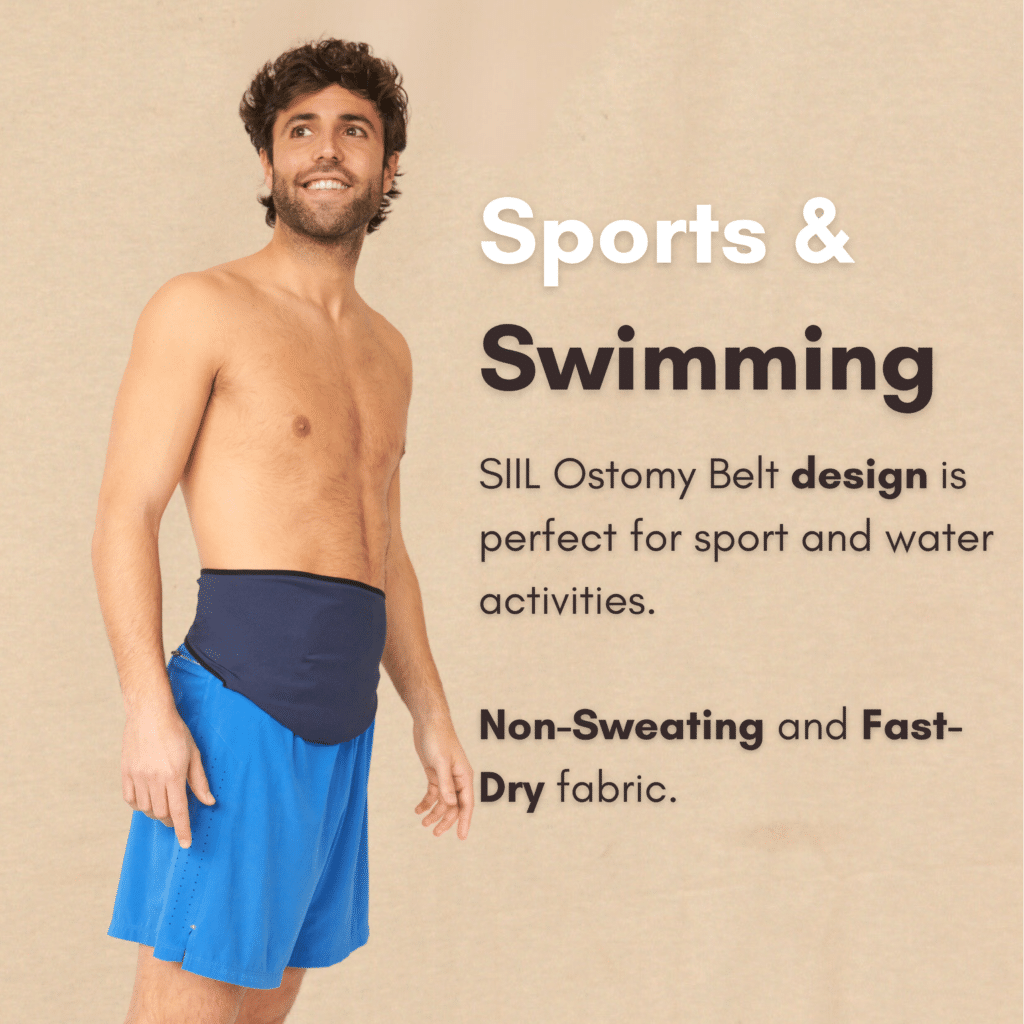
FREE DELIVERY IN USA OVER $120
FREE DELIVERY IN EUROPE OVER $100
Exercise with a stoma requires careful consideration but can be a positive and healthy part of your routine. Starting with low-impact activities like walking, swimming, or cycling is ideal. It’s important to avoid putting excessive pressure on your abdominal area, especially in exercises that heavily involve core muscles.
Wearing an ostomy belt or a supportive garment helps to secure your stoma pouch during these activities. Staying hydrated is also crucial while exercising. Before beginning any new exercise regimen, consulting with a healthcare professional or an ostomy nurse is essential to ensure that the routine is safe and suitable for your specific condition.
Regular exercise not only aids in physical health but also boosts mental well-being, making it a valuable aspect of living well with a stoma.
Your complete guide to exercise with an Ostomy

Living with a stoma can present a range of challenges, but it shouldn’t prevent you from enjoying leisure activities such as swimming. Swimming is not only a fun activity, but it is also a great way to stay fit and healthy. Here’s what you need to know about swimming with a stoma.
Exercising with an ostomy bag can be a rewarding and safe activity when done correctly.
It’s important for ostomy patients to engage in physical activities as it enhances overall health and aids in adjusting to life with an ostomy.
When you start exercising, choosing the right type of exercise is key. Low-impact activities like walking, swimming, and yoga are great options that reduce the risk of putting too much pressure on the ostomy area.
Core exercises should be approached with caution, and heavy lifting should be avoided initially.
Using an ostomy support belt or wrap can provide extra support to the ostomy bag and stoma during exercise, ensuring comfort and security. Always check with your healthcare provider before beginning any new exercise regimen to ensure it aligns with your health status and ostomy care needs.
With the right approach, exercising with an ostomy bag can be a normal and beneficial part of your lifestyle.
Exercise with a stoma can be a beneficial and safe part of your lifestyle when approached correctly.
If you have a stoma, it’s important to start with gentle, low-impact exercises such as walking, swimming, or cycling. These activities minimize stress on the abdomen while keeping you active.
Core strengthening exercises are beneficial but should be approached cautiously to avoid excessive pressure on the stoma area.
Wearing a supportive ostomy belt or garment is recommended to secure the stoma pouch during exercise. Hydration is key, especially during physical activity. Consulting with a healthcare professional or ostomy nurse before starting any new exercise regimen is essential for tailored advice and to ensure your activities are safe and suitable for your specific needs.
Regular exercise not only enhances physical health but also contributes significantly to mental well-being, making it a vital component of life with a stoma.
Why is important?
Exercising with an ostomy bag has numerous benefits. It helps improve cardiovascular health, strengthens the muscles, boosts immunity, and reduces stress.
Colostomy training is an essential process for individuals who have undergone a colostomy surgery. This training typically involves learning how to care for the colostomy stoma, manage the colostomy bag, and understand the changes in lifestyle and diet that may be necessary.
It often includes guidance on how to clean and change the bag, as well as how to monitor the stoma for any signs of infection or irritation. Diet and nutrition advice is also a crucial part of colostomy training, helping individuals adapt to foods that are more comfortable and safer to eat.
Emotional support and counseling might also be provided, as adjusting to life with a colostomy can be challenging.
Most importantly, colostomy training empowers individuals to lead a normal and active life post-surgery. It’s usually conducted by specialized nurses or healthcare professionals who are experienced in ostomy care.
Tips for Exercising with an Ostomy Bag
Get clearance from your doctor: Before you start exercising, it is crucial to get clearance from your doctor. Your doctor will advise you on the best exercises to do and precautions to take.
Choose the right workout gear: Comfortable and breathable workout clothes can help reduce irritation around the stoma. Consider wearing a support belt to keep your ostomy bag in place.
Hydrate: It is essential to stay hydrated when exercising with an ostomy bag. Drinking enough water will help prevent dehydration, which can cause constipation and other complications.
Start slow: It is advisable to start slow and gradually increase the intensity and duration of your workouts. This will help you avoid injury and adapt to your new routine.
Listen to your body: Your body will give you cues on when to stop or take a break. It is crucial to listen to your body and take breaks when necessary.
Core exercises for ostomy patients are a vital component in maintaining strength and stability, but they require careful selection and execution.
For those with an ostomy, gentle core-strengthening exercises like pelvic tilts, seated knee lifts, and certain types of yoga poses can be particularly beneficial. These activities focus on enhancing core stability without exerting undue pressure on the ostomy site. It’s crucial to start with low-intensity exercises and gradually increase the intensity as comfort and strength improve.
Using a support garment or ostomy belt during these exercises can provide additional protection and confidence.
Always consult with a healthcare provider or a specialized ostomy nurse before starting any new exercise routine to ensure it aligns with your specific health needs.
Integrating appropriate core exercises into your fitness regimen can significantly improve your overall health and well-being as an ostomy patient.
Resuming exercise after colostomy surgery is a step towards regaining your strength and normal routine. Start with low-impact activities such as walking or gentle stretching.
These exercises help in improving circulation, reducing the risk of blood clots, and enhancing overall recovery. Gradually, as your body heals and with your doctor’s approval, you can incorporate more varied forms of exercise.
The key is to listen to your body and avoid any activity that causes discomfort around the surgery site. Using a stoma guard or support belt during exercise can provide extra security and comfort.
Remember, patience and gradual progression are crucial for a safe return to fitness post-colostomy surgery.
Post-ileostomy, engaging in physical activity is important for your recovery and well-being.
Initially, focus on gentle, low-impact exercises like walking or stationary cycling. These activities are less likely to irritate the ileostomy site and help in maintaining muscle tone and stamina. It’s important to avoid heavy lifting or high-impact exercises in the early weeks post-surgery.
As you recover and gain strength, gradually introduce more challenging exercises, always being mindful of how your body feels.
Consult with your healthcare provider for personalized advice and timelines. Wearing a supportive ostomy belt during workouts can help secure the ileostomy bag, offering peace of mind as you exercise.
Resuming exercise after stoma surgery requires a cautious and gradual approach.
Begin with light activities such as walking, which helps in promoting blood flow and reducing the risk of post-surgical complications. As you gain strength and with your doctor’s guidance, you can slowly add more exercises into your routine.
Core strengthening exercises should be approached with caution to avoid putting undue stress on the stoma. Protective gear like a stoma guard can be beneficial during exercise to provide extra support.
Always prioritize your comfort and avoid any activities that cause pain or discomfort around the stoma.
Consulting with a healthcare professional for a tailored exercise plan post-stoma surgery is advisable for a safe and effective fitness journey.
Low-impact exercises: Low-impact exercises such as walking, swimming, and cycling are gentle on the body and do not put too much strain on the stoma.
Core exercises: Strengthening your core muscles can help prevent hernias and other complications. Consider doing exercises such as planks, bridges, and pelvic tilts.
Strength training: Strength training can help build muscle and increase bone density. However, it is essential to start with light weights and gradually increase the intensity.
Benefits and Importance of Ostomy Training
Exercising with an ostomy bag is not only possible but also beneficial for your overall health. By following the tips above and choosing the right exercises, you can maintain an active lifestyle and prevent complications.
When it comes to exercising with an ostomy bag, choosing the right workout gear is essential. This is where ostomy clothing and an ostomy belt come in handy.
Wearing comfortable and breathable Clothing can help reduce irritation around the stoma, while an ostomy belt can help keep the ostomy bag in place during exercise.
In addition to regular exercise, swimming can be a great way to stay active and maintain good health. However, for individuals with an ostomy bag, finding the right swimming garment is crucial. Specialized ostomy swimwear can provide the necessary support and coverage, allowing you to enjoy swimming without worrying about leaks or discomfort.
In summary, when it comes to exercising with an ostomy bag, choosing the right gear is just as important as choosing the right exercises. With the right ostomy clothing, ostomy belt, and ostomy swimming garments, you can maintain an active lifestyle and prevent complications.
Yes, you can exercise with an ostomy bag. In fact, regular exercise can help improve cardiovascular health, strengthen the muscles, boost immunity, and reduce stress.
Low-impact exercises such as walking, swimming, and cycling are gentle on the body and do not put too much strain on the stoma. Core exercises such as planks, bridges, and pelvic tilts can help strengthen the core muscles and prevent hernias. Strength training can also help build muscle and increase bone density, but it is important to start with light weights and gradually increase the intensity.
Comfortable and breathable workout clothes can help reduce irritation around the stoma. Consider wearing a support belt to keep your ostomy bag in place. For swimming, specialized ostomy swimwear can provide the necessary support and coverage.
Staying hydrated is essential when exercising with an ostomy bag. Drinking enough water will help prevent dehydration, which can cause constipation and other complications.
It is important to get clearance from your doctor before starting to exercise. Your doctor will advise you on the best exercises to do and precautions to take. Starting slow and gradually increasing the intensity and duration of your workouts can help you avoid injury and adapt to your new routine. It is also important to listen to your body and take breaks when necessary.
Share this with a friend:
DISCOVER OSTOMY ACCESSORIES:
DISCOVER MORE ARTICLES ABOUT OSTOMY